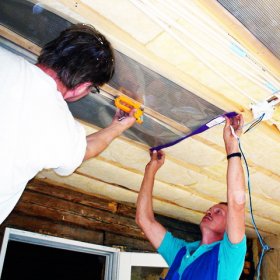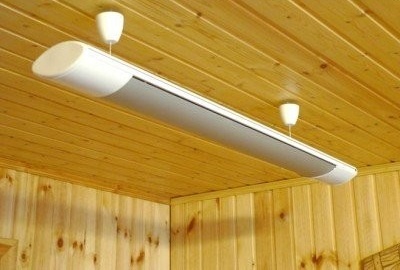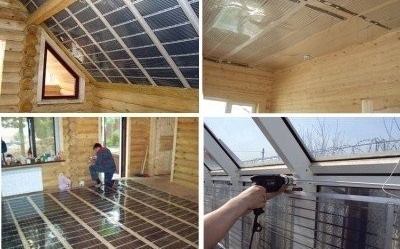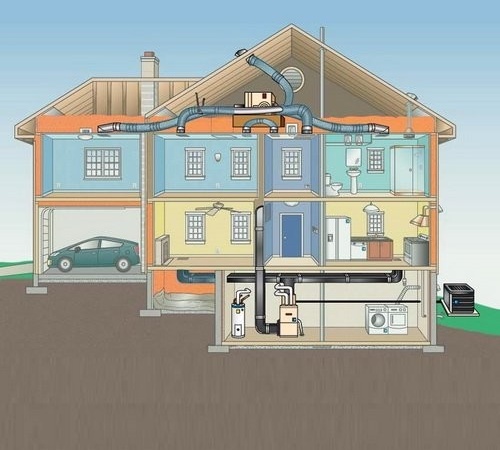Features of the infrared heating device of a private house: how is this system better than others?

Heating systems in our latitudes, where the temperature in the winter sometimes drops to 30 degrees and below, play a decisive role. While residents of cities do not have to choose especially because of the existence of a centralized heating system, owners of individual houses have more degrees of freedom in choosing the principle of heating their homes. Of undoubted popularity among other options for creating a comfortable thermal regime are infrared (IR) heating systems, which ensure uniform heating of the room and allow energy saving. However, there are some features of the arrangement of the IR heating system for private homes, which we want to tell you about.
The main difference between the infrared principle of heating a home from a traditional water heater is that it is not indoor air that is heated, but planes and objects. They then give back the accumulated heat, creating the necessary temperature balance in the heated zone. Thus, the displacement of cold air masses by warm ones, as well as the regular concentration of heated air under the ceiling of the room, does not occur. The room is heated evenly - the air temperature is the same throughout the height of the room. Importantly, infrared heating of a private house is an energy-saving solution and allows you to save about 50% of electricity compared to other options for heating homes.
Content
Types of infrared heating
Ceiling infrared heating systems
With infrared heating of the ceiling type, heating devices are suspended from the ceiling - due to this, the heat flow is directed downward and slightly to the sides. Thus, the main surface that is heated by infrared rays is the floor covering. Therefore, the temperature at the level of the person’s legs with this method of heating is a couple of degrees higher than at the level of his head. With the convective principle of heating the air, the floor is always the coldest surface, and the bulk of the warm air "lives" under the ceiling.
Good to know! Structurally, a ceiling infrared heater includes a heating element (heating element) and a reflective plate made of aluminum, which emits electromagnetic waves of a certain length. Tena is made of tungsten, quartz or ceramic - the power and efficiency of the entire heater as a whole depends on the material used.
Quite often, ceiling heaters are used as an auxiliary heat source in a private house.Maintaining the background temperature in the room using another type of heating and using IR ceiling heaters, you can create “islands” of heat, for example, in a recreation area, workplace or dining group. Note that this does not take the usable area of the room.

By means of infrared heaters of ceiling fastening it is possible to heat the room both in full, and zone
Having an integrated temperature sensor, the IR heater will turn off when the set temperature is reached and turn on for heating if the room temperature drops below the set point. Thus, a considerable amount of electricity is saved. Heating with infrared heaters of the ceiling type is also good because the heating devices can be dismantled and transported, say, to a new place of residence.
In the ceiling space of a private house, infrared film heating can be successfully installed, which will allow to keep the height of the premises and the area of the living space unchanged. This is especially important on the attic floors with a sloping ceiling and small wall planes. More recently, a new type of ceiling IR panels mounted in a Armstrong type profile has appeared on the market of finishing materials - a simple and economical solution for common areas in a private house.
It's important to know! The directed flow of infrared radiation must be avoided. It is impossible for the heating device to be directed to the area of the human head. It is not recommended to mount infrared heaters on a stretch ceiling made of PVC film or on plastic lining, and also to place them below 1.5 meters from the floor surface.
Wall-mounted infrared heating systems
Installing wall mounted infrared heating panels can be a good alternative to traditional radiator heating. With a small thickness and a wide variety of sizes, IR heating panels can be easily mounted in a private house with your own hands.
Infrared panel heaters are available in the form of:
- wall IR panels installed instead of the usual radiator in a niche under the window;
- design wall IR panels of various sizes and in an extensive color scheme;
- planks of warm IR skirting boards that are mounted around the perimeter of the room instead of the usual skirting board
A universal option for wall heating is a film heating system mounted in the thickness of the wall. It is rational to install this type of heat source indoors with one or more external walls - this will ensure sufficient heating of the surfaces prone to freezing and mold formation. An important point that you need to pay attention to when installing the IR film system is the mandatory use of a shielding film that prevents heat loss.
Floor infrared heating systems
As floor IR heating systems, film mats are used, in which flat heating elements are connected in series. The minimum thickness of this heating system allows you to mount a warm floor for any finishing coating - whether it is tile, laminate, carpet or linoleum. In this case, not a single centimeter of the room height will be lost. The most effective heat transfer combination of IR heating is with ceramic tiles, a little worse - with a laminate. The greatest shielding of infrared radiation is seen behind linoleum and carpet.
In addition to the above advantages, the laying of an infrared film is quick, not accompanied by dirty work, such as, for example, when arranging a water heated floor.Installation of decorative flooring can be done right there, without numerous steps that accompany the installation of other types of underfloor heating.
It's important to know! When arranging floor IR heating, it is not recommended to put a film under the furniture - this will reduce heat transfer and can provoke drying out of wooden and wood-shaving furniture structures.
Advantages and disadvantages of IR heating
Like any system for creating comfortable living conditions in a private house, space heating using infrared radiation is not without its positive and negative sides.
Advantages of arranging heating in a house using infrared radiation:
- Infrared radiation is like solar heat and does not violate a healthy indoor climate - it does not dry air and does not burn oxygen. In addition, due to the reduced air circulation during infrared heating, dust particles are not transferred as intensely as with a convective heating system. There are studies that medium-wave infrared radiation has beneficial effects on the human body.
- IR heating can be applied zonally, combined with another heating system at home, or act as an autonomous heat source.
- Film heating systems based on IR heating elements are perfectly combined with floor and wall decorative coatings.
- The low inertia of the infrared heating system means that it does not need time "to swing", as a water coolant. Room heating begins immediately after turning on the IR system and allows you to combine it with thermostats.
- For the IR heating system, voltage drops in the central electrical network are not critical, which suggests a high reliability and durability of heating with infrared radiation.
- When using a floor or wall heating system, it is possible to lay an IR film on only 50-60% of the room area in order to achieve a comfortable temperature in the room.
- Installation of infrared film and IR heaters is easy to do on our own, as it does not require specific knowledge or skills.
- Due to the modularity of the film infrared heating, the failure of one segment of the film does not entail the complete incapacity of the entire heating system. Replacing a faulty element of a film underfloor heating is quite simple and does not require the installation of a new heating strip.
- Electricity consumption by the IR heating system is about 50 W / m2 in hour.

Infrared heating devices create a comfortable microclimate in the room, evenly heating nearby surfaces, which then give off heat
Despite the fact that infrared heating has many advantages, it is impossible not to mention its cons:
- Be that as it may, the principle of infrared heating is based on electromagnetic radiation, which does not always have a positive effect on the human body. In addition, static electricity builds up on heating surfaces, which can attract dust.
- Despite the cost-effectiveness of IR systems, it is initially necessary to invest a significant amount in equipment that will pay off in a few years.
- If zone heating with infrared radiation will cost a little money, then the use of heating with infrared radiation as the only heat source can result in an unbearable amount during operation.
- There is an opinion that excessive heating of surfaces in a room by IR radiation can adversely affect the operation of household appliances.
Summarizing all of the above, it can be noted that the infrared heating system can become a rational, economical, quickly mounted option for both basic and zone heating for a private house.




